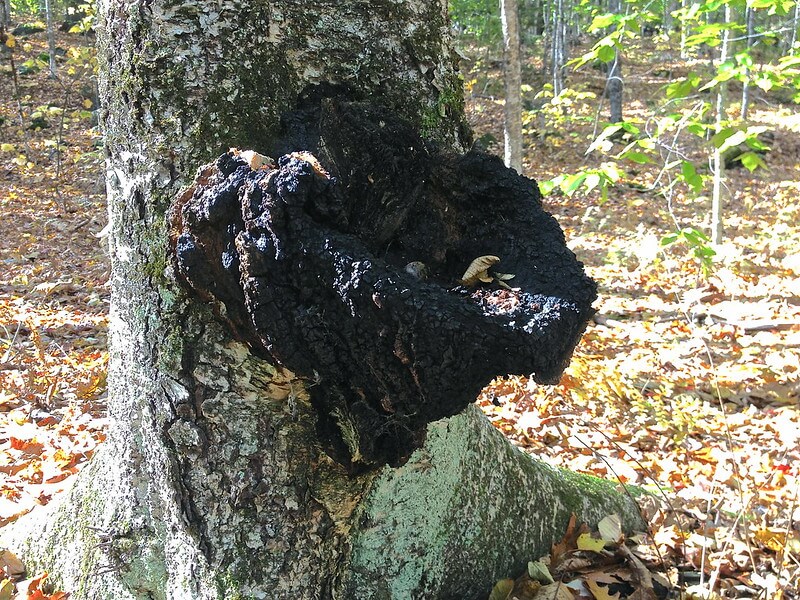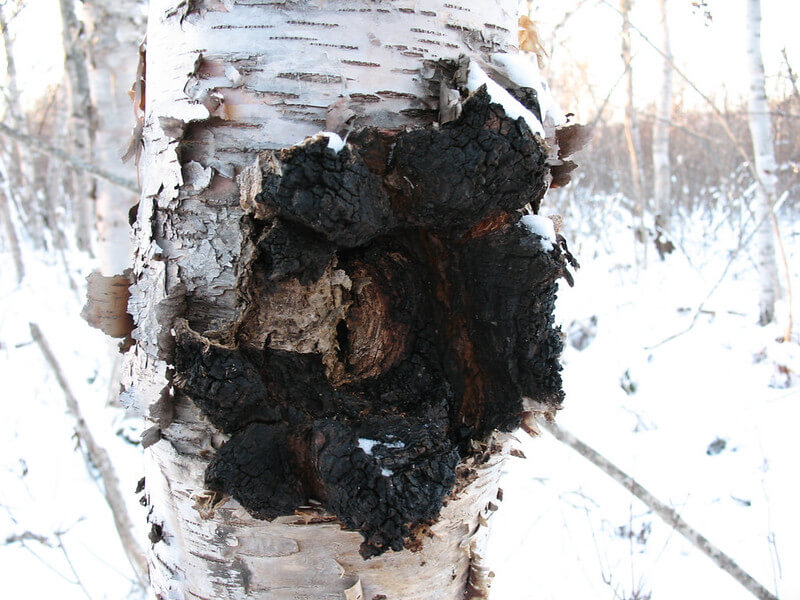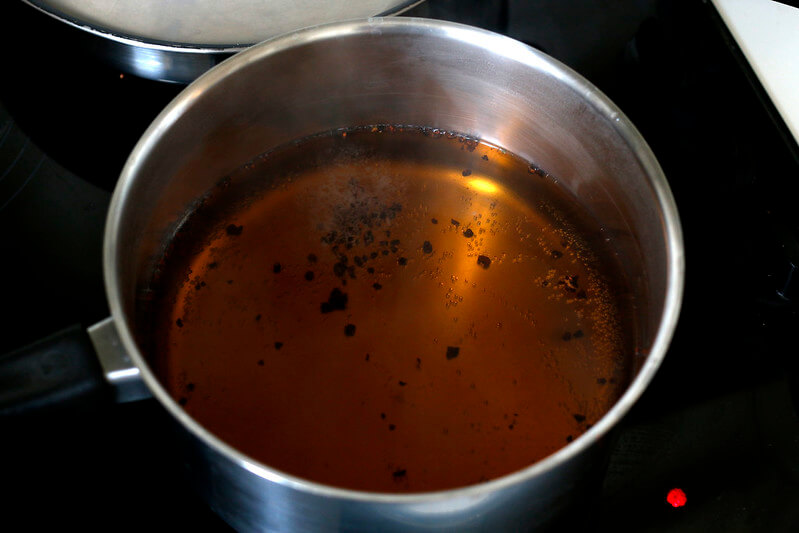If you live within the circumboreal region of the Northern Hemisphere, and especially if you live near birch forests, this article could be pertinent to you.
We will be talking about Chaga: What it is, associated health benefits, and how to forage for it.

What Is Chaga?
Chaga (Inonotus obliquus) is a parasitic fungus that grows on trees. It has shown a preference for birch trees, and where you find stands of birch, you can find Chaga. Chaga is only found in the circumboreal region of the Northern Hemisphere. This basically means it’s found in the northern parts of the Northern Hemisphere (if you aren’t familiar with the term “circumboreal”). It’s a circle that reaches around the globe in the north that contains boreal forests. Essentially, colder climates in deciduous forests.
Chaga is easy to identify on trees. It has a distinct appearance. It almost looks like a big burnt marshmallow, or an oddly shaped piece of charcoal stuck to the side of the tree. Its growth form creates large cankers on the outside of trees and the color is black on the outside with brownish-orange coloration deeper in the canker. This woody growth is called a conk.
Chaga conks aren’t often confused with anything else, but if they are, it is with a tree burl. From a distance they can look similar. Up close you will be able to tell the difference. Chaga is a separate organism from the tree, whereas a tree burl is part of the tree itself and is formed due to a disease or injury earlier in the life of the tree.
As already discussed, Chaga tends to show favoritism toward birch trees, and 99% of the time, this is the tree where you will find it. It is currently unknown why Chaga likes birch and specifically, paper birch (Betula papyrifera), but it is theorized it’s the abundance of melanin in the birch that attracts Chaga. Both Chaga and birch trees have long lifespans, and because of this, Chaga is associated with old-growth birch forests.
Though Chaga is parasitic, leaching nutrients and water from the tree in order to grow, it is not believed that Chaga kills the trees — although older birch trees in Chaga-prone areas die with Chaga on them.
As a fun fact, when the birch dies, the Chaga will slowly die as well due to a lack of nutrients to siphon.
It is this parasitic relationship that gives Chaga the nutrients it is known for. Even more, the nature of both organisms (the Chaga and the birch) being old growth is exactly what allows the Chaga to absorb so many nutrients. Chaga grown in a lab or found on young trees lacks many of the nutrients that it is known for. Like the saying: “Good things take time.”
Nutritional Benefits of Chaga
Because of Chaga’s nature, it absorbs nutrients from its host tree. These nutrients are strong in antioxidants, antimicrobials, and healthy compounds such as polyphenols, unsaturated fatty acids, vitamin K, and more.
Cancer Prevention
Chaga has gathered attention in cancer prevention research and immune support. Research has shown that the triterpenoid extract Chaga contains is able to inhibit the growth of lung cancer cells. Many studies on cancer cells show that extracts from Chaga have anti-tumor effects for cervical, liver, and colon cancers. The polysaccharide compounds present in Chaga have been shown to specifically target and destroy cancer cells without harming healthy cells that are present. Lastly, the complexes of polysaccharide and triterpenoid in Chaga have been shown to inhibit cancer cell proliferation.
Immune System Support
With regard to immune support, there have been many studies on mice that show enhanced immune responses, antibody production, and anti-allergic activity when given Chaga extracts in various forms. In similar kinds of studies, it has been seen that diabetic mice given Chaga extracts, experience decreased blood glucose levels and insulin levels.
Energy Boost
Some say they notice a boost in their energy after they drink Chaga. Chaga does not contain caffeine, so it is a bit mysterious what causes the boosted energy. Because of this, you may want to be careful about what time of day you choose to drink Chaga.
Chaga’s Rising Popularity in Health Stores
Chaga has been medicinally used for centuries by cultures ranging from Ainu, First Nations, Chinese, Russian, Korean, and other indigenous groups. As with many herbal medicines and functional mushrooms, it has now made it into western cultures and is being recognized for its health benefits. This is why there seems to have been a sudden explosion of Chaga-related goods in various health food stores.

The Cost of Chaga
The reason Chaga is so expensive in many of these stores is because of the growth patterns listed above. Geographically speaking, Chaga isn’t found in a large section of the world. Chaga needs older forests to thrive and produce the nutrient-rich conk that we, as humans, desire. And again, Chaga can’t be quickly grown in labs.
Therefore, the Chaga you find in stores comes directly from the forest, and more importantly, from someone who is out there ethically harvesting it themselves.
Chaga Usage and Application
Using Chaga is easy and straightforward.
Chaga Coffee and Tea
Most Chaga that can be purchased in stores comes pre-ground with directions for how much to apply to your beverage to brew. However, if you’re harvesting from the forest, you’re going to come away with chunks of Chaga. It’s important to make sure you allow these to dry out to prevent mold. You may choose to break down the larger masses in small pieces or grind it. If you decide to keep the Chaga in large chunks, you can easily boil the bigger pieces in a pot of water and reuse.

You’ll know the hunk of Chaga is finished when the color of the hot water becomes light brown to colorless. Generally, Chaga tea is very dark in nature.
Chaga Supplements
Some choose to take Chaga supplements. You can easily pack ground Chaga into a veggie capsule yourself if you would rather take it this way. Many prefer to take Chaga tinctures which can also be created at home.
Chaga has a distinctly earthy taste, slightly bitter, like you would imagine the smell of the forest to taste. It isn’t bad at all, and I rather enjoy the flavor. If you would like to spice up your Chaga tea with something unique, try adding Labrador tea. If you live in the region where Chaga is present, you likely live around Labrador tea as well and can easily harvest this on your Chaga foraging trips.
Related Post: What Is Labrador Tea?
Chaga Dip as Chewing Tobacco
Because of the associated energy boost, I have been told that some indigenous groups actually dip Chaga. “Dip” as in chewing tobacco. They take a pinch of ground Chaga, place it within their lip, spit out the liquid as it forms, and “get high” from it.
Ethical Chaga Harvest
To harvest Chaga ethically, it is essential that you follow some guidelines.
Though the birch that Chaga is growing on receives nothing from the fungus, you can kill the tree, if you remove it improperly. A tree can die due to removing too much of the fungus (thereby removing parts of the tree) and leaving gaping holes that can easily become infected.
Here is a list of steps to follow to ensure both safety for the tree and respect for the Chaga:
1. First, locate the Chaga.
2. Ensure the Chaga you are attempting to harvest is at least the size of your outstretched hand.
3. Chaga that is too young will not survive a harvest. By harvesting Chaga that is at least hand-size, you are helping ensure the Chaga will be able to regrow and come back year after year. This is important both for mitigating the possibility of injuring the host tree, and ensuring you and future harvesters will not have to go farther and farther into the woodlands to find Chaga.
4. It is recommended to harvest Chaga during colder months. This timing is because trees usually don’t run sap in winter and infection is greatly reduced when it is cold outside.
5. Only harvest a portion of the Chaga you have located. As mentioned, harvesting too much is the main cause of tree injuries, and the main reason a Chaga patch does not regrow and come back annually.
How to Harvest Chaga
To harvest, you need a hatchet and perhaps a long, sturdy, sharp knife.
Aim the hatchet at an angle toward the base of the Chaga patch. Once you begin to hit the patch, you can wedge the hatchet into the conk and peel back the bulk of it. You will notice the inside of the Chaga is bright orange.
Some prefer to take the sharp knife and mark the extent of the harvest on the Chaga conk. Once the knife is in place, you hit it with the back of the hatchet. This technique allows the harvest to be cleaner and more precise. Plus, it is less likely Chaga chunks will fly off and be lost. I recommend using the knife method if you are unsure of your aim with a hatchet. Using the knife can also ensure that you don’t take too much of the Chaga and injure that patch or the host tree.
When I was taught about Chaga harvest, I was told to hug the birch tree afterward and give thanks. Whether or not this is in your practice, it’s always important to give gratitude to the land for what it has given you.









































Leave a Reply